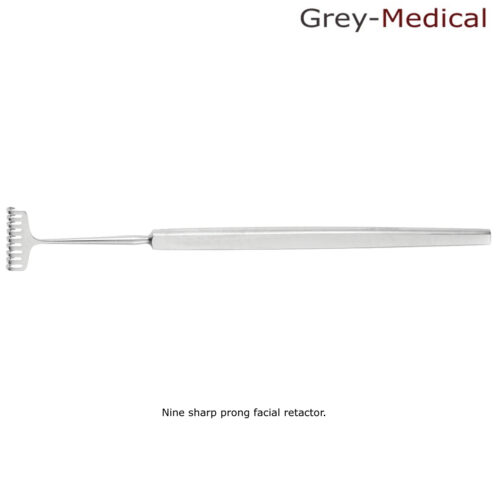Introduction
Surgeons rely on a vast array of instruments to carry out complex operations, and retractors are among the most important. Within the category of retractors, rake retractors hold a significant position due to their unique design and effectiveness in maintaining a clear operating field. In this blog, we will explore the function of rake retractors, their variations, and their importance in different surgical disciplines.
Function of Rake Retractors
At its core, a rake retractor is used to hold back tissues, muscles, or skin, providing better access to the area being operated on. This increased visibility is crucial for the surgeon to work efficiently without interference from surrounding tissues. The pronged, rake-like design is key to its function, allowing the instrument to “hook” onto tissue and gently pull it away from the surgical site.
The rake retractor, therefore, serves two vital functions: improving the surgeon’s line of sight and ensuring that sensitive tissues are not accidentally harmed during the procedure.
Different Types of Rake Retractors
Rake retractors come in several variations, each designed to handle different types of tissues and surgeries. Here are the most commonly used ones:
- Sharp Rake Retractors: These retractors have pointed prongs that are used for gripping tougher tissues such as muscles or dense connective tissue. They are often used in orthopedic surgeries or during procedures where muscle retraction is necessary.
- Blunt Rake Retractors: Blunt-tipped rake retractors are more suitable for softer tissues, making them ideal for plastic or cosmetic surgeries. They hold tissues in place without causing trauma, which is particularly important in facial procedures.
- Wide Pronged Rake Retractors: These retractors feature broader prongs and are used for larger areas where more significant retraction is required. They are commonly used in general surgeries such as abdominal operations.
How Rake Retractors Aid Surgeons
Surgical procedures often require precise and meticulous movements, and the ability to see and access the area being worked on is essential for success. Rake retractors provide this crucial assistance by holding back surrounding tissues and giving the surgeon a clear, unobstructed view.
For example, during rhinoplasty, a surgeon needs to reshape the nasal structure without damaging delicate tissues. Small, blunt rake retractors are commonly used in such procedures to gently hold back skin and soft tissue while maintaining the integrity of the nasal structure.
In contrast, during orthopedic surgeries, where the surgeon needs access to bones and joints, sharp rake retractors are used to grip and hold back muscles, ensuring the bones are fully exposed for treatment.
Materials and Durability
Most rake retractors are crafted from high-grade stainless steel, ensuring they are both durable and resistant to corrosion. Stainless steel is also easy to sterilize, which is critical in maintaining hygiene standards in operating rooms. These instruments are designed to last, able to withstand repeated sterilization cycles and the wear and tear of surgical use.
In terms of design, the handles are often curved or ergonomically shaped, allowing surgeons to maintain a firm, comfortable grip. This feature is especially beneficial during longer surgeries, where hand fatigue could otherwise become an issue.
The Role of Rake Retractors in Patient Safety
One of the key benefits of using rake retractors is the increased safety they provide for patients. By holding tissues in place, these retractors prevent accidental nicks or cuts to adjacent structures, reducing the risk of complications such as bleeding or infection.
Additionally, by minimizing tissue trauma during retraction, rake retractors help to reduce postoperative recovery times and improve the overall outcome for the patient.
Applications in Various Medical Fields
Rake retractors are used in a wide variety of medical fields due to their versatility and effectiveness. Some of the most common applications include:
- Plastic and Reconstructive Surgery: Rake retractors are used to gently hold back skin and other soft tissues, giving surgeons a clear view of the area they are working on.
- Orthopedic Surgery: Sharp rake retractors are used to pull back muscles and provide access to bones and joints.
- General Surgery: Whether in abdominal surgeries or hernia repairs, rake retractors are often employed to hold back tissues and organs, allowing for more precise work.
Conclusion
Rake retractors are indispensable in modern surgery, offering surgeons the visibility and control they need to perform complex procedures. Available in various designs tailored to different tissue types, these instruments contribute to safer, more efficient surgeries, ultimately benefiting both patients and surgeons. As medical technology continues to evolve, the role of these versatile instruments will remain integral to surgical success.
